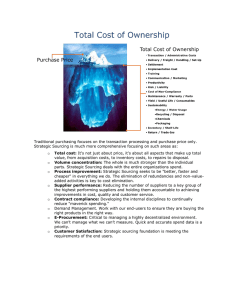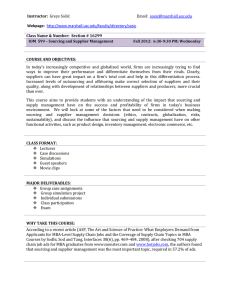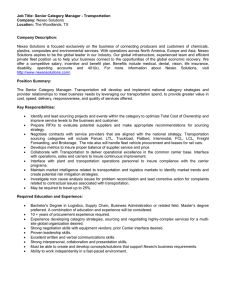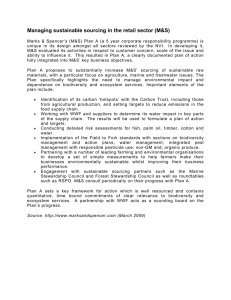International Sourcing Moving Business Functions abroad Peter Bøegh Nielsen Statistics Denmark
advertisement
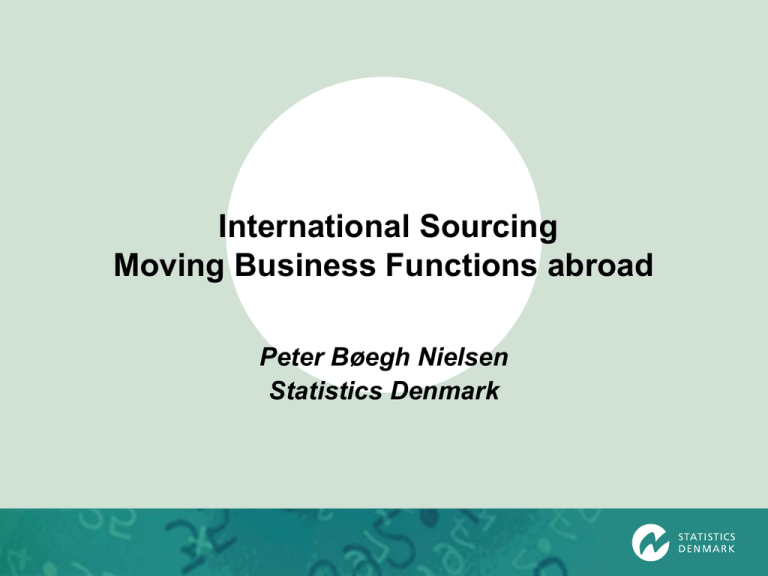
International Sourcing Moving Business Functions abroad Peter Bøegh Nielsen Statistics Denmark Contents • Survey on measuring International Sourcing – – – – Background Definition of International Sourcing Definition of Business Functions Survey design and results • Micro Data Linking • Measuring Global Value Chains Policy issues addressed • How many jobs are moved across borders? Which type of jobs and in which sectors? • Who are the receiving countries? • What are the overall employment impacts – in terms of job losses or gains? • What is the impact of international sourcing on the competitiveness of European firms? • Is there a risk of “hollowing out“ skill based activities? Measurement Challenges • • • • 4 Transnational activities Inter-enterprise relations Intra-enterprise organisation Introducing new concepts Definition of insourcing and outsourcing CONTROL LOCATION External production outside the enterprise or enterprise group Domestic Sourcing (Outsourcing) Production outside the enterprise or group by nonaffiliated enterprises but within the compiling country International Sourcing (Outsourcing) Production outside the enterprise or group and outside the compiling country by non-affiliated enterprises. This involves foreign subcontracting Internal production within the enterprise group Domestic Sourcing (Insourcing) Production within the enterprise group to which the enterprise belongs and within the compiling country International Sourcing (Insourcing) Production within the group to which the enterprise belongs but abroad (by affiliated enterprises) The Business Statistics Approach Opening the black box of the enterprise INPUT ENTERPRISE OUTPUT €£$ LABOUR PRODUCTION GOODS TURNOVER Opening the black box of the enterprise by introducing 8 generic Business Functions Core business function: Production of final goods or services intended for the market/for third parties carried out by the enterprise and yielding income. Support business function: Support business functions (ancillary activities) are carried out in order to permit or facilitate production of goods or services intended for the market/for third parties by the enterprise. Distribution and logistics Marketing, sales and after sales services ICT services Administrative and management functions Engineering and related technical services Research & Development Other support functions 7 Model Questionnaire Module 1: General information (for all enterprises) Module 2: Sourcing activity of the enterprise (for all enterprises) Module 3: Sourcing activity of the enterprise carried out internationally during 2001-2006 (for enterprises carrying out international sourcing in 2001-2006) Module 4: Plans for international sourcing 2007-2009 (for enterprises with no prior international sourcing activity) Module 5: Future impact on employment (for enterprises with international sourcing during 2001-2006 and/or plans for international sourcing during 20072009) Module 6: Barriers on international sourcing (for all enterprises) 8 Share of enterprises carrying out international sourcing 45 % 40 35 30 25 20 15 10 5 0 Total CZ* DK DE IE IT Enterprises having sourced internationally 2001-2006 NL* PT* SI FI SE UK Enterprises having plans for international sourcing 2007-2009 NO Destinations for international sourcing. Core functions International sourcing by business partner. Share of enterprises with international sourcing Germany Italy Netherlands Czech Rep. Portugal Ireland 0 20 Within enterprise group (insourcing) 40 60 Other foreign enterprises (outsourcing) 80 100 Per cent Sourcing intensity, breakdown of enterprises by the number of functions sourced Czech Republic Italy Denmark Norway 1 function sourced, Total Netherlands 2 function sourced, Total Finland 3 function sourced, Total Slovenia Portugal Ireland 0 % 20 % 40 % 60 % 80 % 100 % Contents • Survey on measuring International Sourcing – – – – Background Definition of International Sourcing Definition of Business Functions Survey design and results • Micro Data Linking • Measuring Global Value Chains Micro Data Linking Project • Developing methodology for micro data linking • Utilising existing statistical registers: International Sourcing survey, SBS and Foreign Trade • Focusing on measuring impacts on employment and trade patterns Contents • Survey on measuring International Sourcing – – – – Background Definition of International Sourcing Definition of Business Functions Survey design and results • Micro Data Linking • Measuring Global Value Chains Why expand the scope to GVCs? • Demand from policy makers: EU 2020 strategy: The Commission will draw up a framework for a modern industrial policy. The framework will address all elements of the increasingly international value chain from access to raw materials to after-sales service. • Real economy justification: Increased fragmentation of the production chain Increased digitalization of tasks, especially services Growing global trade in intermediates Rising trade between affiliates Measuring GVCs Issues to be addressed • (1) Revising the scope – Not only measure movements but also structures • (2) Developing a standardised classification of business functions – Utilise existing methodological experiences to develop and propose a classification • (3) Revising the questionnaire – How to measure the volume of business functions? • (4) Furthering micro data linking – Build upon existing experiences and include new registers, e.g. FATS, R&D 18 The Road ahead • • • • • Revision of questionnaire July 2011 Launching of new survey Q.4 2011 Full scale survey 2012 (first half) Dissemination of results 2013 Micro data linking 2012 (second half 2012) • Dissemination of results 2013 Thank you for your attention! If any questions, you are most welcome to contact me : pbn@dst.dk
